Cleaning a glass stovetop can be a daunting task, especially if you are not familiar with the right techniques and cleaning products. But with the right approach, you can keep your glass stovetop looking brand new for years to come. In this article, I will share some easy and effective tips on how to clean a glass stovetop.
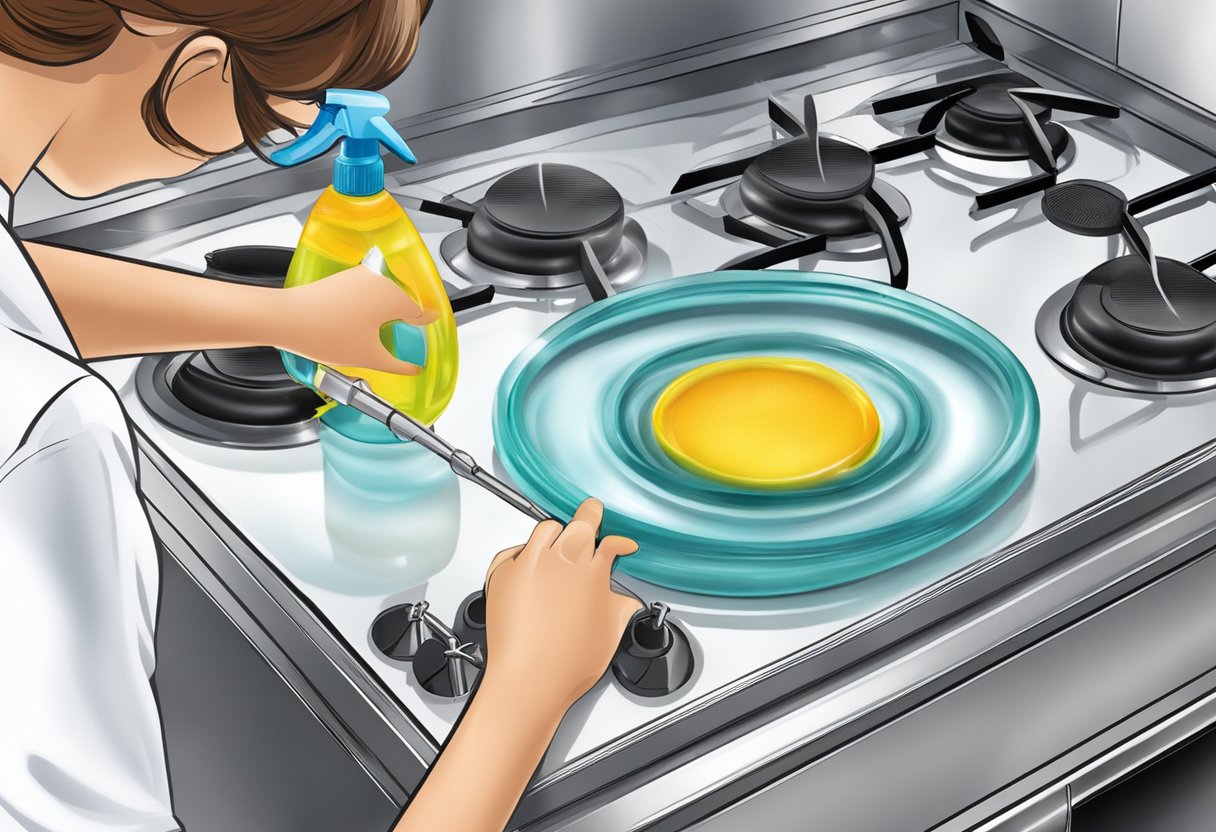
Before you start cleaning your glass stovetop, it’s important to understand the material you’re working with. Glass stovetops are made of tempered glass, which is known for its durability and resistance to heat. However, it’s also prone to scratches and damage from abrasive cleaning tools or harsh chemicals. Therefore, it’s essential to use the right cleaning products and tools to avoid damaging your glass stovetop.
Key Takeaways
- Use non-abrasive cleaning tools and homemade cleaning solutions to avoid scratching your glass stovetop.
- Commercial cleaning products can be effective, but make sure to read the labels and use them according to the manufacturer’s instructions.
- Regular maintenance and prevention are key to keeping your glass stovetop looking clean and new.
Understanding Your Glass Stovetop
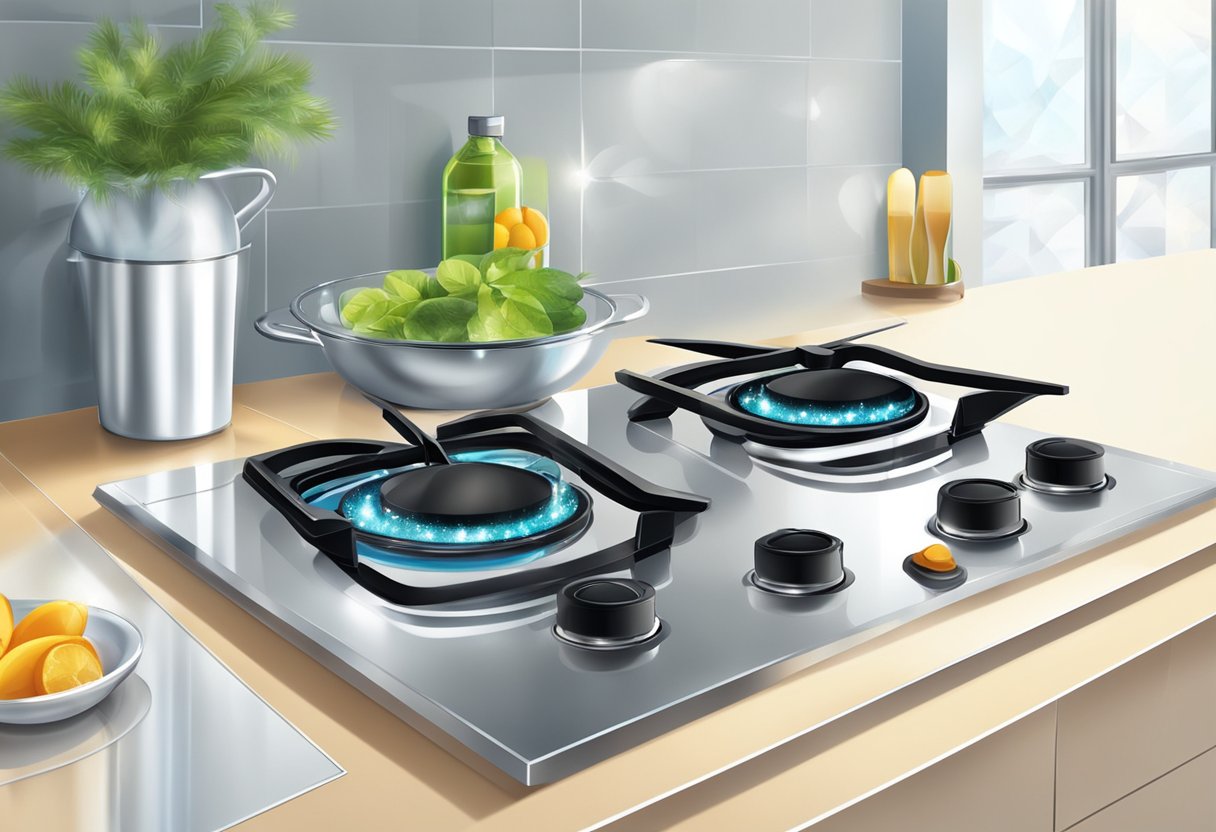
As a proud owner of a glass stovetop, I understand the importance of keeping it clean and looking new. Glass stovetops are a popular choice for many homeowners due to their sleek appearance and ease of use. However, they require extra care and maintenance to keep them in top condition.
Before we dive into the cleaning process, let’s first understand what a glass stovetop is and how it differs from other types of stovetops. A glass stovetop is a smooth surface made of tempered glass that sits on top of heating elements. Unlike traditional gas ranges or electric stovetops with coils or burners, a glass stovetop has a flat surface that provides even heat distribution.
It’s important to note that glass stovetops are delicate and can easily scratch or crack. That’s why it’s crucial to follow the manufacturer’s instructions and warranty guidelines when it comes to cleaning and maintaining your glass stovetop. Most warranties for glass stovetops require the use of specific cleaning products and discourage the use of abrasive materials.
Glass stovetops are available in both electric and induction cooktops. Induction cooktops use electromagnetic energy to heat the cookware directly, while electric cooktops use heating elements under the glass surface. Both types of glass stovetops have a smooth surface that makes cleaning easier.
In summary, a glass stovetop is a popular choice for many homeowners due to its sleek appearance and ease of use. It’s important to follow the manufacturer’s instructions and warranty guidelines to keep your glass stovetop in top condition. Glass stovetops are available in both electric and induction cooktops, and both types have a smooth surface that makes cleaning easier.
Pre-Cleaning Steps
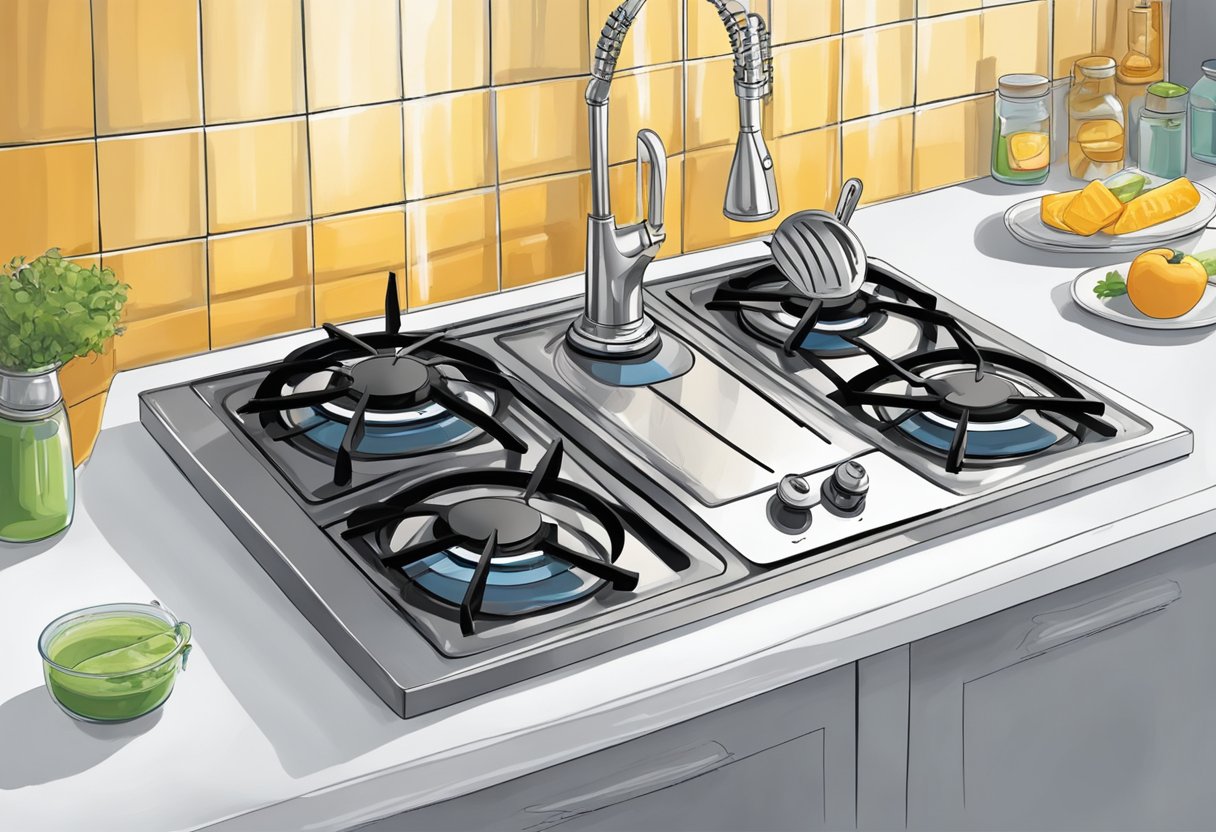
Before I start cleaning my glass stovetop, I make sure to take a few pre-cleaning steps to ensure that the cleaning process goes smoothly. Here are some of the steps that I take:
- Turn off the stove: Before I start cleaning, I make sure to turn off the stove and let it cool down completely. This is important to prevent any burns or accidents while cleaning.
- Remove any loose debris: I use a soft cloth or a microfiber cloth to remove any loose debris, such as crumbs or bits of food, from the stovetop. This helps to prevent any scratches or damage to the stovetop while cleaning.
- Wipe down the stovetop: After removing any loose debris, I use a soft cloth or a microfiber cloth to wipe down the stovetop. This helps to remove any dust or dirt that may have accumulated on the stovetop.
- Clean up spills and stains quickly: If there are any spills or stains on the stovetop, I make sure to clean them up as quickly as possible. This helps to prevent any damage or discoloration to the stovetop.
By taking these pre-cleaning steps, I ensure that my glass stovetop is ready for a thorough cleaning.
Using Homemade Cleaning Solutions
https://www.youtube.com/watch?v=McYu-iV3Els&embed=true
Cleaning a glass stovetop can be challenging, but using homemade cleaning solutions can make the task easier and more affordable. Here are a few DIY cleaning solutions that I have found effective:
Baking Soda and Water
Baking soda is a natural cleaner that can effectively remove stains and grime from a glass stovetop. To use baking soda as a cleaner, mix it with water to create a paste. Apply the paste to the stovetop and let it sit for a few minutes. Then, use a damp cloth to wipe away the paste and the grime.
Vinegar and Water
Vinegar is another natural cleaner that can be used to clean a glass stovetop. Mix equal parts of vinegar and water in a spray bottle. Spray the solution onto the stovetop and let it sit for a few minutes. Then, use a damp cloth to wipe away the solution and the grime.
Baking Soda and Vinegar
Combining baking soda and vinegar can create a powerful cleaning solution for a glass stovetop. First, sprinkle baking soda onto the stovetop. Then, spray the vinegar and water solution onto the baking soda. Let the solution sit for a few minutes, and then wipe away the grime with a damp cloth.
Distilled White Vinegar
Distilled white vinegar is a stronger version of regular vinegar and can be used to clean a glass stovetop more effectively. Mix equal parts of vinegar and water in a spray bottle and apply the solution to the stovetop. Let it sit for a few minutes and then wipe away the grime with a damp cloth.
Using homemade cleaning solutions can be a cost-effective and natural way to clean a glass stovetop. However, it is important to test any cleaning solution on a small area of the stovetop before using it to clean the entire surface. This can help prevent any damage or discoloration to the stovetop.
Commercial Cleaning Products
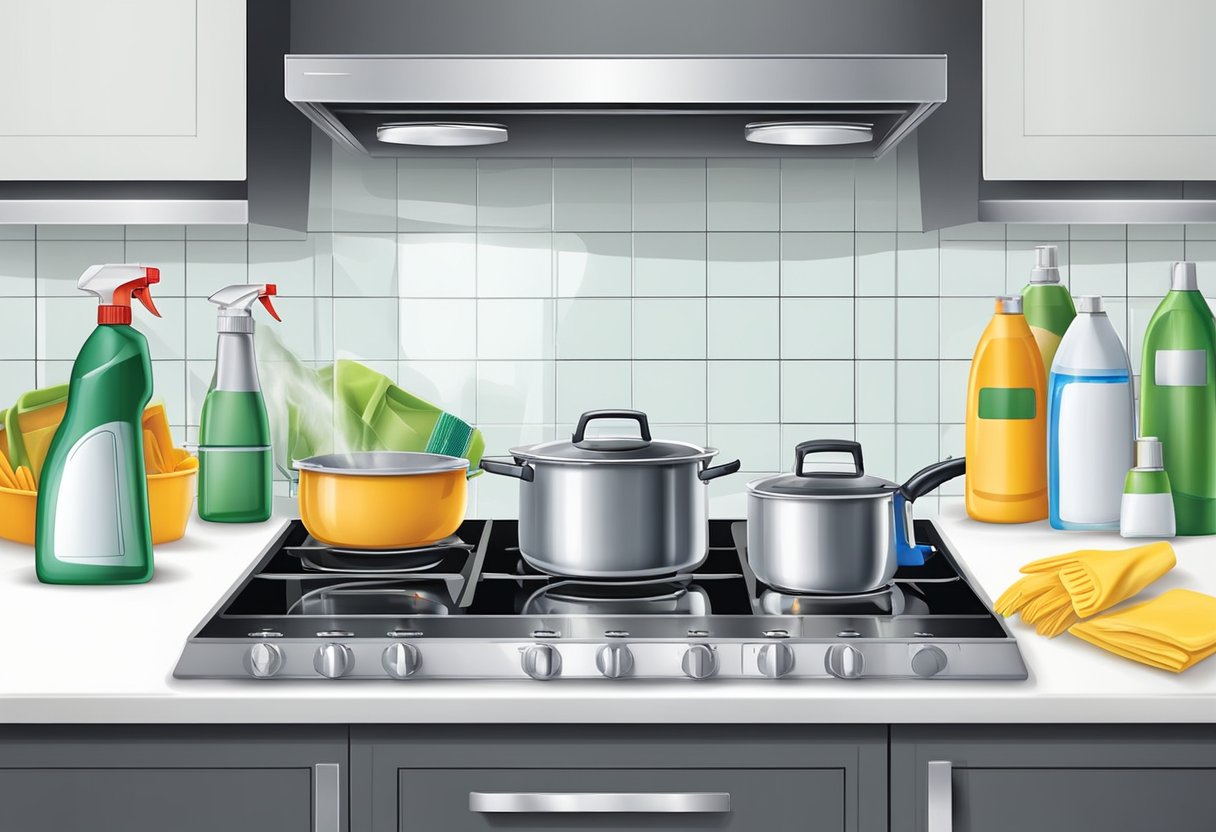
When it comes to cleaning a glass stovetop, there are a variety of commercial cleaning products available on the market that can make the job easier. These products are specifically designed to remove tough stains and grime from your stovetop without damaging the surface.
One popular option is a non-abrasive cleaning pad, which can be used with a commercial cleaner to remove stubborn stains. These pads are gentle enough to use on a glass stovetop without scratching the surface. When using a cleaning pad, be sure to follow the manufacturer’s instructions for best results.
Another option is a cooktop cleaner, which is specifically designed for use on glass stovetops. These cleaners often contain a degreaser, which can help to break down stubborn grease and grime. Some cooktop cleaners also contain ammonia, which can be effective at removing tough stains.
When choosing a commercial cleaner for your glass stovetop, be sure to choose a non-abrasive formula that is safe for use on glass surfaces. Always follow the manufacturer’s instructions for best results, and be sure to test the cleaner on a small, inconspicuous area of your stovetop before using it on the entire surface.
Overall, commercial cleaning products can be a great option for cleaning your glass stovetop. They are specifically designed to remove tough stains and grime without damaging the surface, and can make the job of cleaning your stovetop much easier.
Dealing with Stubborn Stains and Spills
https://www.youtube.com/watch?v=9wFD6tQR7AQ&embed=true
Cleaning a glass stovetop can be a daunting task, especially when dealing with stubborn stains and spills. Here are some tips to help you tackle these tough messes:
Stains
Stains on a glass stovetop can be caused by a variety of things, from tomato sauce to chocolate. To remove stains, start by wiping the surface with a non-abrasive cleaning pad to remove any loose debris. Then, apply a cleaning solution of equal parts white vinegar and water to the stain and let it sit for a few minutes. Finally, wipe the surface clean with a damp microfiber cloth. For tougher stains, you may need to repeat this process a few times.
Spills
Spills on a glass stovetop can be caused by anything from rice to pasta. To clean up spills, start by wiping the surface with a damp cloth to remove any loose debris. Then, apply a cleaning solution of equal parts white vinegar and water to the spill and let it sit for a few minutes. Finally, wipe the surface clean with a damp microfiber cloth.
Burnt-on Food
Burnt-on food and burn marks on a glass stovetop can be a challenge to remove. To tackle these tough messes, start by scraping off any burnt-on food with a razor blade held at a 45-degree angle. Then, mist the area lightly with vinegar and carefully scrape off any remaining residue. Finally, wipe the surface clean with a damp microfiber cloth.
Grease
Grease can leave a stubborn residue on a glass stovetop. To remove grease, start by wiping the surface with a non-abrasive cleaning pad to remove any loose debris. Then, apply a cleaning solution of equal parts white vinegar and water to the grease and let it sit for a few minutes. Finally, wipe the surface clean with a damp microfiber cloth.
By following these tips, you can keep your glass stovetop looking clean and shiny. Remember to always use non-abrasive cleaning pads and microfiber cloths to avoid scratching the surface.
Using Tools for Cleaning
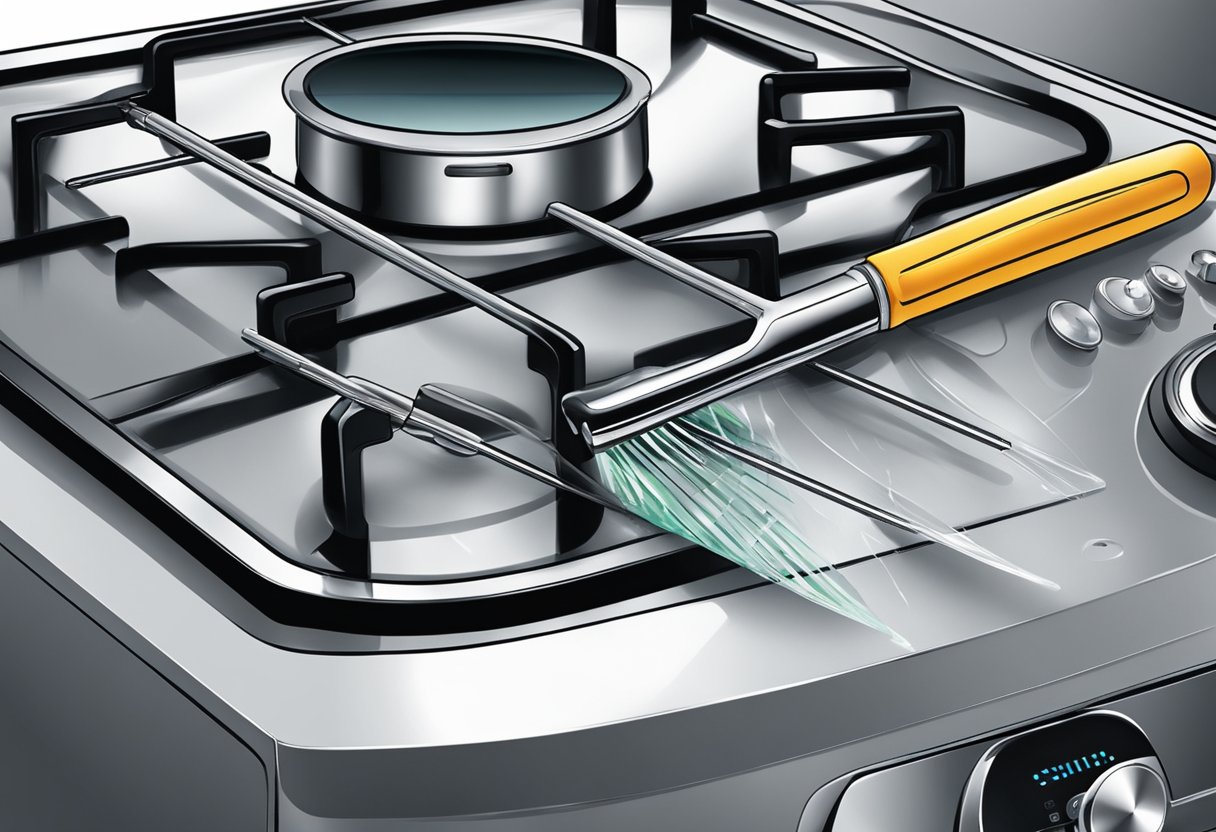
When it comes to cleaning a glass stovetop, there are a few tools that can be very helpful. Here are some tools that I recommend using:
Razor Blade or Scraper Tool
A razor blade or scraper tool can be used to remove any burnt-on food or stains that are stuck to the stovetop. When using a razor blade or scraper tool, make sure to hold it at a 45-degree angle and carefully scrape off the debris. It’s important to be gentle and not press too hard, as this can scratch the surface of the stovetop.
Microfiber Cloths
I highly recommend using microfiber cloths when cleaning a glass stovetop. Microfiber cloths are gentle and won’t scratch the surface of the stovetop. They’re also very absorbent, which makes them great for wiping up spills and cleaning up messes.
Non-Abrasive Cleaner
When cleaning a glass stovetop, it’s important to use a non-abrasive cleaner. Abrasive cleaners can scratch the surface of the stovetop, which can make it look dull and worn over time. Instead, use a cleaner that is specifically designed for glass stovetops.
Towels
Towels are great for drying off the stovetop after it has been cleaned. Make sure to use a clean, dry towel to avoid leaving any streaks or water spots on the surface of the stovetop.
Overall, using the right tools can make cleaning a glass stovetop much easier and more effective. By using a razor blade or scraper tool, microfiber cloths, non-abrasive cleaner, and towels, you can keep your glass stovetop looking clean and shiny for years to come.
Preventing Damage and Scratches
https://www.youtube.com/watch?v=9dhHBbP96r0&embed=true
As someone who has cleaned many glass stovetops, I know how frustrating it can be to see scratches and damage on the surface. That’s why it’s important to take steps to prevent damage and scratches from occurring in the first place.
One of the most important things to keep in mind is to avoid using abrasive materials on the glass surface. This includes steel wool, which can cause deep scratches that are difficult to remove. Instead, opt for non-abrasive materials like soft cloths or sponges.
Another important step is to always read and follow the manufacturer’s instructions for cleaning and care. They may recommend specific products or methods that are safe for your particular stovetop.
It’s also a good idea to label any cleaning products that you use on your glass stovetop to avoid any confusion or accidental use of abrasive materials. This can save you from costly repairs or replacements down the line.
Finally, be mindful of what you place on the stovetop. Avoid dragging heavy pots or pans across the surface, as this can cause scratching. Instead, lift them off the stovetop and place them down gently.
By taking these simple steps, you can help prevent damage and scratches to your glass stovetop and keep it looking like new for years to come.
Maintaining Your Glass Stovetop
As a homeowner, I know how important it is to keep my kitchen clean and sparkling. One of the most important parts of keeping your kitchen clean is maintaining your glass stovetop. Here are some tips on how to keep your glass stovetop clean and in good condition.
Regular Maintenance
To keep your glass stovetop looking its best, it’s important to clean it after each use. Use a damp cloth or sponge to wipe up spills and drips as soon as they happen. This will help prevent food from sticking to the surface and making it more difficult to clean later on.
Another important part of regular maintenance is to keep the drip pans under your burners clean. These pans can collect grease and food particles, which can then drip onto your stovetop and cause stains. Remove the drip pans and clean them with warm, soapy water on a regular basis.
Deep Cleaning
Even with regular maintenance, your glass stovetop will still need a deep clean from time to time. To deep clean your stovetop, start by removing any loose debris with a non-abrasive cleaning pad. Then, use a glass stovetop cleaner to remove any stubborn stains or burnt-on food.
When using a glass stovetop cleaner, be sure to follow the manufacturer’s instructions carefully. Apply the cleaner to the surface of your stovetop and let it sit for a few minutes. Then, use a non-abrasive cleaning pad to scrub the surface gently. Rinse the surface thoroughly with water and dry it with a clean, dry cloth.
Choosing the Right Cleaners
When it comes to cleaning your glass stovetop, it’s important to use the right cleaners. Avoid using abrasive cleaners or scrubbers, as these can scratch the surface of your stovetop. Instead, use a non-abrasive cleaner that is specifically designed for glass cooktops.
White vinegar and baking soda are also effective natural cleaners that can be used to clean your glass stovetop. Simply mix equal parts white vinegar and water in a spray bottle. Spray the solution onto the surface of your stovetop and sprinkle baking soda over the top. Let the solution sit for a few minutes, then wipe it away with a damp cloth.
By following these simple tips, you can easily maintain and clean your glass stovetop, keeping it looking its best for years to come.
Conclusion
https://www.youtube.com/watch?v=2BxotAZp2v8&embed=true
Cleaning a glass stovetop can seem like a daunting task, but with the right tools and techniques, it can be a breeze. Regular maintenance is key to keeping your glass stovetop looking like new.
To clean your glass stovetop, start by wiping away any loose debris with a soft cloth or paper towel. Then, use a cleaner specifically designed for glass stovetops, such as a vinegar and water solution or a commercial cleaner. Be sure to avoid using abrasive materials or harsh chemicals that can scratch or damage the surface.
When cleaning your glass stovetop, it’s important to be patient and thorough. Take your time and make sure to clean all areas of the stovetop, including the edges and corners. Don’t forget to also clean any knobs or buttons on the stovetop.
In addition to regular cleaning, there are a few maintenance tips you can follow to keep your glass stovetop in top condition. Avoid using heavy or oversized pots and pans that can scratch the surface, and be sure to clean up any spills or splatters as soon as possible.
By following these simple tips, you can keep your glass stovetop looking like new for years to come. So don’t be afraid to tackle that cleaning task – with a little effort, you can have a sparkling clean stovetop in no time!
Frequently Asked Questions
https://www.youtube.com/watch?v=KnS8wTD9Cxg&embed=true
What is the best way to clean a glass stovetop?
The best way to clean a glass stovetop is to use a mixture of white vinegar and baking soda. First, spray the stovetop with white vinegar and then sprinkle baking soda over the vinegar. Next, wet a towel with hot water, wring it out, and place it over the vinegar and baking soda mix. Let the towel sit on the surface for 10 to 15 minutes. Finally, remove the towel and use a microfiber cloth to wipe down the surface.
How can I remove streaks from my glass stovetop?
To remove streaks from your glass stovetop, use a mixture of white vinegar and water. First, mix equal parts of white vinegar and water in a spray bottle. Next, spray the solution onto the stovetop and wipe it down with a microfiber cloth. This should remove any streaks and leave your stovetop looking clean and shiny.
Is it safe to use a razor blade to clean a glass stovetop?
Yes, it is safe to use a razor blade to clean a glass stovetop, but only if you use it correctly. Make sure that the blade is sharp and that you hold it at a 45-degree angle to the stovetop. Use gentle pressure and scrape the blade in a forward motion. Be careful not to scratch the surface of the stovetop.
What is a good alternative to Barkeepers Friend for cleaning a glass stovetop?
A good alternative to Barkeepers Friend for cleaning a glass stovetop is a mixture of baking soda and water. First, mix baking soda and water to form a paste. Next, apply the paste to the stovetop and use a microfiber cloth to scrub the surface. Finally, rinse the stovetop with water and dry it with a clean cloth.
How do you clean a black glass stovetop without scratching it?
To clean a black glass stovetop without scratching it, use a mixture of white vinegar and water. First, mix equal parts of white vinegar and water in a spray bottle. Next, spray the solution onto the stovetop and wipe it down with a microfiber cloth. Avoid using abrasive cleaners or scrubbers, as they can scratch the surface of the stovetop.
What is the most effective natural cleaner for a glass stovetop?
The most effective natural cleaner for a glass stovetop is a mixture of white vinegar and baking soda. First, spray the stovetop with white vinegar and then sprinkle baking soda over the vinegar. Next, wet a towel with hot water, wring it out, and place it over the vinegar and baking soda mix. Let the towel sit on the surface for 10 to 15 minutes. Finally, remove the towel and use a microfiber cloth to wipe down the surface. This natural cleaner is effective at removing grease, grime, and stains from your glass stovetop.
